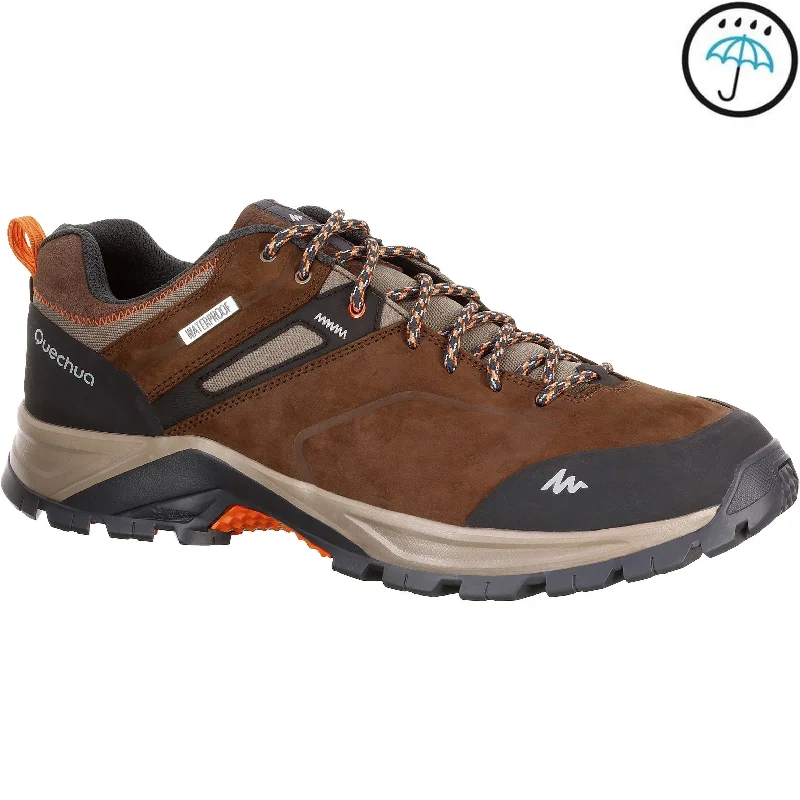Excellent grip and protection in the mountains
---specs---
Crosscontact sole
Lengthy lab research into the design of the sole, combined with a special rubber formulation which optimizes the balance between traction and adhesion. We aim to provide the best compromise when walking on dry and slippery terrain, addressing the differing requirements of each.
Waterproofing test
Footwear waterproofing test: footwear equipped with a waterproof, breathable coating affording optimum protection from the rain; tested in the laboratory and in use. To start, they are immersed in water with pressurized air inside to check that no bubbles form on the surface of the boot. Next, shoes are fitted to a mechanical arm that simulates walking half-immersed in water so we can test that the inside remains perfectly dry.
Waterproofing level
During the waterproofing test, we test 3 levels of waterproofing: 2000 flexes (around 2 hours of walking), 4000 flexes (around 4 hours of walking) and 8000 flexes (around 8 hours of walking). Of course, after this test or in use, the shoe regains its original waterproofing once dry.
The Forclaz 500 waterproof passes the 8000 flexes test.
Making waterproofing last longer
A shoe's waterproofing is often undermined by water getting in from the top of the shoe. Using waterproof gaiters or mini gaiters is therefore recommended to keep your feet dry for longer by protecting the top part of your shoes and prevent water from getting in as well as pebbles, sand, etc.
Use of a re-waterproofing spray is recommended several times per year. This will help your shoes recover their original water repellent qualities and combat outer stains.
Purchase advice
Try on both shoes, standing up, with the socks worn for hiking.
Try on several models or sizes if necessary.
Check two comfort points: the base of the heel and the front part of the foot going down.
Avoid all pressure points when trying them on.
Don't hesitate to walk around the store.
Gradually start using you shoes during your first few hiking trips to break them in.
Which size should I select?
For hiking, take the size above your usual shoe size to ensure optimum comfort when traveling downhill and to prevent your toes from hitting the end of the shoes. Tip: keep your toenails short and check that your laces stop your foot from sliding to the front of the shoes before you start downhill.
Field test
All our shoes undergo use and comfort tests carried out by users representative of the target market in typical conditions of use. Our Field Test Missions team up the product manager with people unconnected with QUECHUA, to test, improve, and approve our products.
Lab tests
Other laboratory tests are also conducted to approve the quality of the following components: eyelet and strap attachment, sticking, toxicology, UV resistance, wearing of sole and upper components, early wear and tear.
Product Testing
All our shoes undergo use and comfort tests carried out by users representative of the target market in typical conditions of use. In our field tests the product manager works with people outside QUECHUA to test, improve, and approve our products.
Weight
14.6oz per shoe in size 9
Composition
Outer sole of : 50.0% Ethylene Vinyl Acetate, Outer sole of : 50.0% Rubber - Butadiene Rubber\r\nUpper of : 80.0% Bovine leather, Upper of : 20.0% Polyester cationic\r\nLining and sock of : 100.0% Polyester cationic
Restrictions
Not suitable for trekking
Storage Instructions
Store in a well ventilated dark, dry place.
Guarantee
2 Years
---/specs---
---catchline---
The ideal shoe for regular hikes in the mountains. With its rubber stone guard, leather upper, waterproof coating and grippy sole, you can hike with full confidence
---/catchline---
---features---
---/features---
---made_for---
day-long mountain hikes, in all weather conditions, on technical trails. for regular use.
---/made_for---

